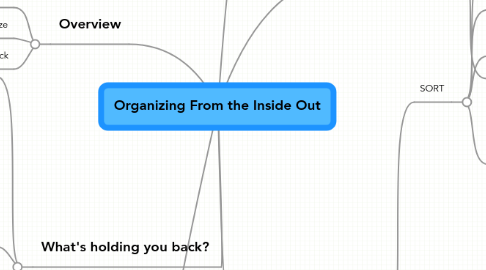
1. Overview
1.1. Analyze
1.1.1. Where you are now?
1.1.2. Where are you going?
1.1.3. What's holding you back?
1.1.4. Why it's important to get there?
1.2. Strategize
1.2.1. Plan of action to transform space
1.2.2. Realistic schedule
1.3. Attack
1.3.1. Methodically dive into clutter
1.3.2. Sort and arrange to reflect way you think
1.3.3. Visible results while working
2. What's holding you back?
2.1. Technical errors
2.1.1. Items lack home
2.1.2. Inconvenient storage
2.1.3. More stuff than space
2.1.4. Complex, confusing systems
2.1.5. Out of sight, out of mind
2.1.6. Organizing seems boring
2.2. External realities
2.2.1. Unrealistic workload
2.2.2. Speed of life
2.2.3. In transition
2.2.4. Uncooperative partners
2.2.5. Limited space
2.3. Psychological obstacles
2.3.1. Need for abundance
2.3.2. Conquestador of chaos (macho)
2.3.3. Fear of losing creativity
2.3.4. Need for distraction
2.3.5. Dislike the space
2.3.6. Sentimental attachment
2.3.7. Need for perfection
3. Summary
3.1. Skills for a lifetime
3.2. Apply skill over and over to any task
3.3. Pride, personal identity, sense of peace
4. ANALYZE
4.1. Take stock
4.1.1. What's not working?
4.1.2. What items are most essential?
4.1.3. Why do you want to get organized
4.1.4. What's causing the problems?
5. STRATEGIZE
5.1. Activty zones (Kindergarten Model)
5.1.1. Easy to focus on one activity at a time
5.1.2. Everything needed is in zone
5.1.3. Everything labeled
5.1.4. Visual menu to inhabitants of space
5.1.5. Transform
5.1.5.1. Define zones
5.1.5.2. Map out space
5.1.5.3. Rearrange furniture
5.2. Schedule transformation
5.2.1. Estimate time (1 - 1 1/2 days per room)
5.2.2. Establish a schedule
5.2.3. Schedule appointments and honor them
6. ATTACK (S.P.A.C.E)
6.1. SORT
6.1.1. Group similar items
6.1.2. Handle every item
6.1.2.1. Do I use?
6.1.2.2. Do I love it?
6.1.3. Determine category
6.1.4. Sorting secrets
6.1.4.1. Start with what you can see (not hidden)
6.1.4.2. Quick sort for quick results
6.1.4.2.1. Identify
6.1.4.2.2. Categorize
6.1.4.2.3. Running list of to-dos that come up
6.1.4.3. Avoid zig zag organizing
6.1.4.3.1. Work one section at a time
6.1.4.3.2. Use a "belongs elsewhere" box
6.2. PURGE
6.2.1. Benefits of reducing
6.2.1.1. Space
6.2.1.2. Time
6.2.1.3. Money
6.2.1.3.1. storage cost
6.2.1.3.2. donation value
6.2.2. Methods
6.2.2.1. Toss
6.2.2.2. Giveaway
6.2.2.3. Sell
6.2.2.4. Put elsewhere
6.2.2.5. Store
6.3. ASSIGN a home
6.3.1. Decide on appropriate zone
6.3.2. Assign each item a single and consistent home
6.3.3. Guidelines for Assigning Homes
6.3.3.1. Appropriate sizing
6.3.3.2. Single function storage
6.3.3.3. Logical sequencing (similar groups near each other)
6.3.3.4. Accessibility (easy to retrieve and put back frequently used items)
6.3.3.5. Safety
6.4. CONTAINERIZE
6.4.1. Easier cleaning
6.4.2. Limits amount accumulated
6.4.3. Selecting
6.4.3.1. Asthetics - love them
6.4.3.2. Sturdiness - don't economize
6.4.3.3. Managability - easy to handle when full
6.4.3.4. Size - proper fit for number of items (little room for growth)
6.4.4. Shopping list
6.4.4.1. Measure, measure, measure
6.4.5. Label
6.4.5.1. Supports multiple people
6.4.5.2. Ensures things put back
6.4.5.3. Label maker best
6.5. EQUALIZE
6.5.1. Maintaining system
6.5.2. Reevaluate every 2 weeks to ensure it is working
6.5.3. Daily cleanup
6.5.3.1. No room should take more than 3-5 minutes
6.5.4. Periodic Tuneups
6.5.4.1. Evaluate a few times a year
6.5.4.2. Make adjustments
6.5.4.3. Purge elements not working
6.5.4.4. Keep fun and engaging
